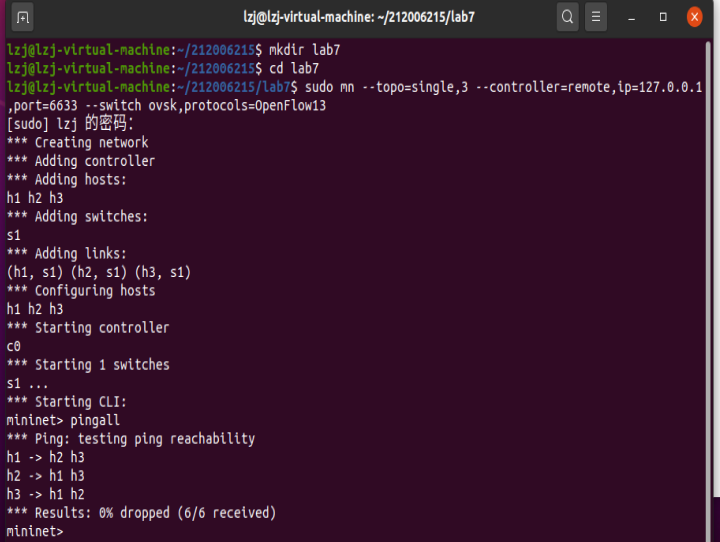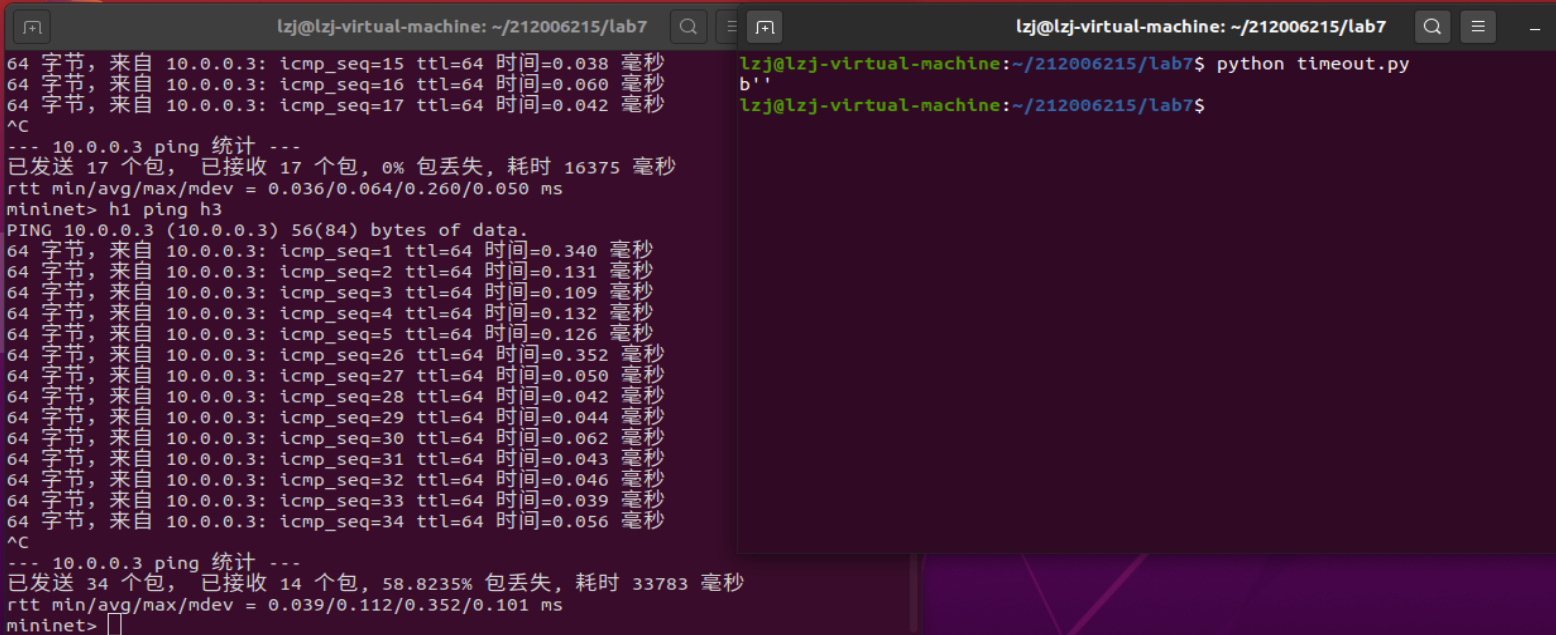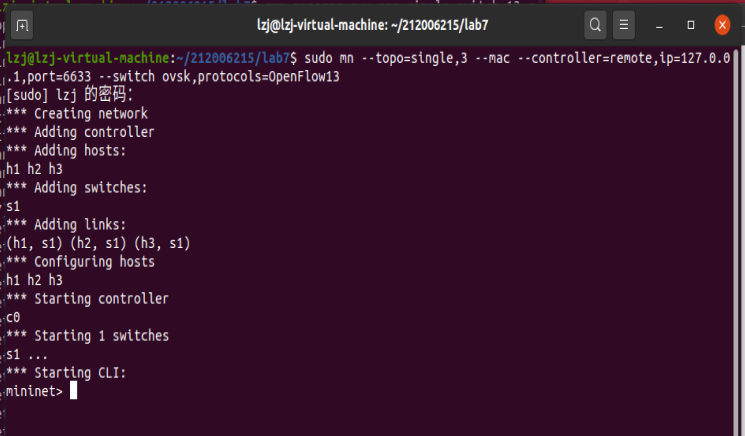实验7:基于REST API的SDN北向应用实践
一、实验目的
- 能够编写程序调用OpenDaylight REST API实现特定网络功能;
- 能够编写程序调用Ryu REST API实现特定网络功能。
二、实验环境
- 下载虚拟机软件Oracle VisualBox或VMware;
- 在虚拟机中安装Ubuntu 20.04 Desktop amd64,并完整安装Mininet、OpenDaylight(Carbon版本)、Postman和Ryu;
三、实验要求
(一)基本要求
- 编写Python程序,调用OpenDaylight的北向接口实现以下功能
(1) 利用Mininet平台搭建下图所示网络拓扑,并连接OpenDaylight;


(2) 下发指令删除s1上的流表数据。
创建del.py文件
点击查看代码
import requests
from requests.auth import HTTPBasicAuth
if __name__ == '__main__':
url = 'http://127.0.0.1:8181/restconf/operational/opendaylight-inventory:nodes/node/openflow:1/'
headers = {'Content-Type': 'application/json'}
response = requests.delete(url=url, headers=headers, auth=HTTPBasicAuth('admin', 'admin'))
print(response.content)

(3) 下发硬超时流表,实现拓扑内主机h1和h3网络中断20s。
timeout.py
#!/usr/bin/python
import requests
from requests.auth import HTTPBasicAuth
if __name__ == "__main__":
url = 'http://127.0.0.1:8181/restconf/config/opendaylight-inventory:nodes/node/openflow:1/flow-node-inventory:table/0/flow/1'
with open("./timeout.json") as file:
str = file.read()
headers = {'Content-Type': 'application/json'}
res = requests.put(url, str, headers=headers, auth=HTTPBasicAuth('admin', 'admin'))
print (res.content)
timeout.json
{
"flow": [
{
"id": "1",
"match": {
"in-port": "1",
"ethernet-match": {
"ethernet-type": {
"type": "0x0800"
}
},
"ipv4-destination": "10.0.0.3/32"
},
"instructions": {
"instruction": [
{
"order": "0",
"apply-actions": {
"action": [
{
"order": "0",
"drop-action": {}
}
]
}
}
]
},
"flow-name": "flow",
"priority": "65535",
"hard-timeout": "20",
"cookie": "2",
"table_id": "0"
}
]
}

(4) 获取s1上活动的流表数。
创建文件flows.py
点击查看代码
#!/usr/bin/python
import requests
from requests.auth import HTTPBasicAuth
if __name__ == "__main__":
url = 'http://127.0.0.1:8181/restconf/operational/opendaylight-inventory:nodes/node/openflow:1/flow-node-inventory:table/0/opendaylight-flow-table-statistics:flow-table-statistics'
headers = {'Content-Type': 'application/json'}
res = requests.get(url,headers=headers, auth=HTTPBasicAuth('admin', 'admin'))
print (res.content)

- 编写Python程序,调用Ryu的北向接口实现以下功能
(1) 实现上述OpenDaylight实验拓扑上相同的硬超时流表下发。



ryu_timeout.py(点击查看代码
import requests
from requests.auth import HTTPBasicAuth
if __name__ == '__main__':
url = 'http://127.0.0.1:8080/stats/flowentry/add'
headers = {'Content-Type': 'application/json'}
json = open('ryu_timeout.json').read()
response = requests.post(url, data=json, headers=headers)
print(response.content)
ryu_timeout.json(点击查看代码
{
"dpid": 1,
"cookie": 1,
"cookie_mask": 1,
"table_id": 0,
"hard_timeout": 20,
"priority": 65535,
"flags": 1,
"match":{
"in_port":1
},
"actions":[]
}
(2) 参考Ryu REST API的文档,基于VLAN实验的网络拓扑,编程实现相同的VLAN配置。
提示:拓扑生成后需连接Ryu,且Ryu应能够提供REST API服务
| VLAN_ID | Hosts |
|---|---|
| 0 | h1 h3 |
| 1 | h2 h4 |
mytopo.py(点击查看代码
from mininet.topo import Topo
class MyTopo(Topo):
def __init__(self):
#initilaize topology
Topo.__init__(self)
#add hosts
h1=self.addHost('h1')
h2=self.addHost('h2')
h3=self.addHost('h3')
h4=self.addHost('h4')
#add Switches
s1=self.addSwitch('s1')
s2=self.addSwitch('s2')
#add Links
self.addLink(h1,s1,1,1)
self.addLink(h2,s1,1,2)
self.addLink(h3,s2,1,1)
self.addLink(h4,s2,1,2)
self.addLink(s1,s2,3,3)
topos = {'mytopo' : (lambda:MyTopo())}
ryu_vlan.py(点击查看代码
import json
import requests
if __name__ == '__main__':
url = 'http://127.0.0.1:8080/stats/flowentry/add'
headers = {'Content-Type': 'application/json'}
f = open('ryu_vlan.json').read()
flows = json.loads(f)['flows']
[requests.post(url, data=json.dumps(flows[i]), headers=headers) for i in range(0, 8)]
ryu_vlan.json(点击查看代码
{
"flows": [
{
"dpid": 1,
"priority": 1,
"match": {
"in_port": 1
},
"actions": [{
"type": "PUSH_VLAN",
"ethertype": 33024
},
{
"type": "SET_FIELD",
"field": "vlan_vid",
"value": 4096
},
{
"type": "OUTPUT",
"port": 3
}
]
},
{
"dpid": 1,
"priority": 1,
"match": {
"in_port": 2
},
"actions": [{
"type": "PUSH_VLAN",
"ethertype": 33024
},
{
"type": "SET_FIELD",
"field": "vlan_vid",
"value": 4097
},
{
"type": "OUTPUT",
"port": 3
}
]
},
{
"dpid": 1,
"priority": 1,
"match": {
"vlan_vid": 0
},
"actions": [{
"type": "POP_VLAN",
"ethertype": 33024
},
{
"type": "OUTPUT",
"port": 1
}
]
},
{
"dpid": 1,
"priority": 1,
"match": {
"vlan_vid": 1
},
"actions": [{
"type": "POP_VLAN",
"ethertype": 33024
},
{
"type": "OUTPUT",
"port": 2
}
]
},
{
"dpid": 2,
"priority": 1,
"match": {
"in_port": 1
},
"actions": [{
"type": "PUSH_VLAN",
"ethertype": 33024
},
{
"type": "SET_FIELD",
"field": "vlan_vid",
"value": 4096
},
{
"type": "OUTPUT",
"port": 3
}
]
},
{
"dpid": 2,
"priority": 1,
"match": {
"in_port": 2
},
"actions": [{
"type": "PUSH_VLAN",
"ethertype": 33024
},
{
"type": "SET_FIELD",
"field": "vlan_vid",
"value": 4097
},
{
"type": "OUTPUT",
"port": 3
}
]
},
{
"dpid": 2,
"priority": 1,
"match": {
"vlan_vid": 0
},
"actions": [{
"type": "POP_VLAN",
"ethertype": 33024
},
{
"type": "OUTPUT",
"port": 1
}
]
},
{
"dpid": 2,
"priority": 1,
"match": {
"vlan_vid": 1
},
"actions": [{
"type": "POP_VLAN",
"ethertype": 33024
},
{
"type": "OUTPUT",
"port": 2
}
]
}
]
}


(二)进阶要求
OpenDaylight或Ryu任选其一,编程实现查看前序VLAN实验拓扑中所有节点(含交换机、主机)的名称,以及显示每台交换机的所有流表项。
点击查看代码
import requests
import time
import re
class GetNodes:
def __init__(self, ip):
self.ip = ip
def get_switch_id(self):
url = 'http://' + self.ip + '/stats/switches'
re_switch_id = requests.get(url=url).json()
switch_id_hex = []
for i in re_switch_id:
switch_id_hex.append(hex(i))
return switch_id_hex
def getflow(self):
url = 'http://' + self.ip + '/stats/flow/%d'
switch_list = self.get_switch_id()
ret_flow = []
for switch in switch_list:
new_url = format(url % int(switch, 16))
re_switch_flow = requests.get(url=new_url).json()
ret_flow.append(re_switch_flow)
return ret_flow
def show(self):
flow_list = self.getflow()
for flow in flow_list:
for dpid in flow.keys():
dp_id = dpid
switchnum= '{1}'.format(hex(int(dp_id)), int(dp_id))
print('s'+switchnum,end = " ")
switchnum = int(switchnum)
for list_table in flow.values():
for table in list_table:
string1 = str(table)
if re.search("'dl_vlan': '(.*?)'", string1) is not None:
num = re.search("'dl_vlan': '(.*?)'", string1).group(1);
if num == '0' and switchnum == 1:
print('h1',end = " ")
if num == '1' and switchnum == 1:
print('h2',end = " ")
if num == '0' and switchnum == 2:
print('h3',end = " ")
if num == '1' and switchnum == 2:
print('h4',end = " ")
print("")
flow_list = self.getflow()
for flow in flow_list:
for dpid in flow.keys():
dp_id = dpid
print('switch_name:s{1}'.format(hex(int(dp_id)), int(dp_id)))
for list_table in flow.values():
for table in list_table:
print(table)
s1 = GetNodes("127.0.0.1:8080")
s1.show()

(三)个人总结
- 这次的实验大部分都是需要代码实现的,对我来说难度较大,在不断地查阅资料和同学的帮助下,完成了本次实验。
- 通过这次实验进一步学习到了ODL REST API和Ryu REST API的使用,进一步学习到了ODL和Ryu北向接口的使用。



 浙公网安备 33010602011771号
浙公网安备 33010602011771号